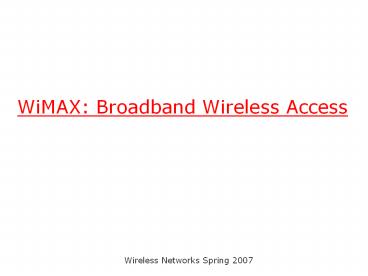WiMAX:%20Broadband%20Wireless%20Access - PowerPoint PPT Presentation
Title:
WiMAX:%20Broadband%20Wireless%20Access
Description:
Burst profiles decided based on QoS needs and channel conditions ... Burst downstream mode. For bursty transmission (IP-based traffic) ... – PowerPoint PPT presentation
Number of Views:89
Avg rating:3.0/5.0
Title: WiMAX:%20Broadband%20Wireless%20Access
1
WiMAX Broadband Wireless Access
2
802.16 Standards Development
- Use wireless links with microwave or millimeter
wave radios - 10-66 GHz
- 802.16a extension to 2-11 GHz
- Use licensed spectrum (unlicensed too in 802.16a)
- Metropolitan in scale
- Provide public network service to fee-paying
customers - Point-to-multipoint architecture with rooftop or
tower-mounted antennas
3
802.16 Standards Development
- Provide efficient transport of heterogeneous
traffic supporting QoS - Capable of broadband transmissions (2-75 Mbps)
- Accommodate both continuous and bursty traffic
- Mobile extensions 802.16e
4
IEEE 802.16 Protocol Architecture
5
Protocol Architecture
- Physical layer functions
- Encoding/decoding of signals
- Preamble generation/removal
- Bit transmission/reception
- Medium access control layer functions
- On transmission, assemble data into a frame with
address and error detection fields - On reception, disassemble frame, and perform
address recognition and error detection - Govern access to the wireless transmission medium
6
Protocol Architecture
- Convergence layer functions
- Encapsulate PDU framing of upper layers into
native 802.16 MAC/PHY frames - Map upper layers addresses into 802.16 addresses
- Translate upper layer QoS parameters into native
802.16 MAC format - Adapt time dependencies of upper layer traffic
into equivalent MAC service
7
IEEE 802.16 Services
- Digital audio/video multicast
- Digital telephony
- ATM
- Internet protocol
- Bridged LAN
- Back-haul
- Frame relay
8
Burst Profiles
- Each subscriber station negotiates a burst
profile with the base station - Burst profiles decided based on QoS needs and
channel conditions - Harsher environment demands more robust profiles
- Favorable environment allows efficient profiles
9
IEEE 802.16.1 Frame Format
- Header - protocol control information
- Downlink header used by the base station
- Uplink header used by the subscriber to convey
bandwidth management needs to base station - Bandwidth request header used by subscriber to
request additional bandwidth - Payload either higher-level data or a MAC
control message - CRC error-detecting code
10
Physical Layer Uplink
- Stations transmit in in their assigned allocation
specified in an initial map - Uplink sub-frame may also contain
contention-based allocations for initial system
access - Uses a DAMA-TDMA technique
- Error correction uses Reed-Solomon codes
- Modulation scheme based on QPSK, 16-QAM or 64-QAM
11
Physical Layer Downlink
- Continuous downstream mode
- For continuous transmission (audio/video)
- Simple TDM scheme is used for channel access
- Frequency division duplex (FDD)
- Burst downstream mode
- For bursty transmission (IP-based traffic)
- DAMA-TDMA scheme for channel access
- FDD with adaptive modulation, frequency shift
division duplexing (FSDD), time division
duplexing (TDD)
12
Medium Access Control (MAC)
- Connection-oriented
- All services inherently connectionless mapped to
a connection - Connections referenced using a 16-bit connection
identifier (CID) - Management channels and transport channels for
contracted services
13
Radio Link Control
- Power control and paging
- Transition among burst profiles
- Downlink burst profile change
- Subscriber station monitors downlink quality
- Requests a new profile
- Granted if base station judges possible
- Uplink profile change
- Base station monitors the uplink signal quality
- Specifies the new profiles usage code when
granting subscriber bandwidth in a frame
14
Bandwidth Requests Grants
- Two kinds of subscribers
- Grant per connection (GPC)
- Grant per subscriber (GPSS)
- Both classes request bandwidth per connection for
QoS guarantees - For GPC, bandwidth explicitly guaranteed to
connection - For GPSS, bandwidth aggregated into a single
grant for SS
15
Requesting Bandwidth
- Unsolicited grants
- No need to request bandwidth for services that
generate fixed units of data periodically - Negotiated at connection setup time
- Send a bandwidth request MAC packet
- Piggyback request within MAC data packet
- Polling by base station
16
MAC Management Messages
- Uplink and downlink channel descriptor
- Uplink and downlink access definition
- Ranging request and response
- Registration request, response and acknowledge
- Privacy key management request and response
- Dynamic service addition request, response and
acknowledge
17
MAC Management Messages
- Dynamic service change request, response, and
acknowledge - Dynamic service deletion request and response
- Multicast polling assignment request and response
- Downlink data grant type request
- ARQ acknowledgment































